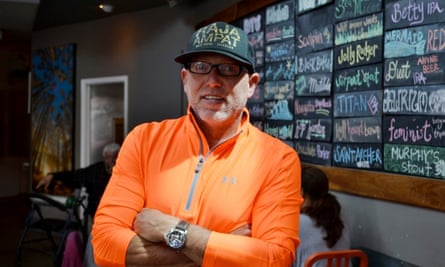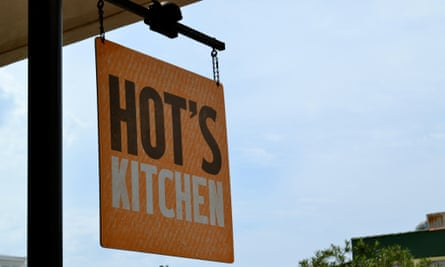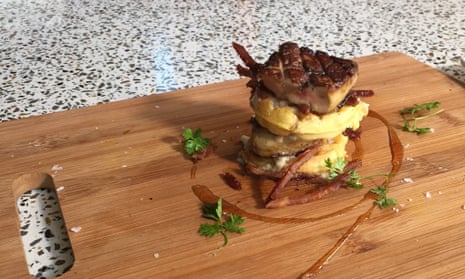Sean Chaney is a California kid at heart who grew up yards from the Pacific Ocean eating In-N-Out burgers and so many tacos his friends nicknamed him “Hot Sauce”. He has also become an unlikely defender of foie gras, the French delicacy so fine Louis XVI declared it the “dish of kings”.
So when California moved to outlaw the millennia-old speciality, chef Chaney joined foie gras producers in New York and Canada in waging a legal battle against the state.
“I didn’t want to see it leave my kitchen,” Chaney said of the delicacy, known for its rich flavor and buttery texture.
At the moment, foie gras is back on the menu, legally, and California’s gourmets can once again enjoy it in restaurants.
Getting the dish back on menus involved death threats, clandestine dinners, and a bevy of lawsuits, Chaney said. But despite the drama, Chaney said fighting for “foie”, as he affectionately calls it, was worth the hassle.
Having your pâté and eating it too
While foie gras is experiencing somewhat of a renaissance in California, its global reputation has been tarnished by shocking videos and images of distressed birds stuffed in individual cages in which they are unable to move.
European countries, including Britain, Norway, Sweden, Germany and Switzerland, have banned the production of foie gras. Celebrity chef Heston Blumenthal dropped his French foie gras supplier after allegations of animal cruelty. And while it was once fit for King Louis XVI’s court, it is no longer to be found on the menu at the household of the Prince of Wales.
Known in French as gavage, the controversial process of producing foie gras involves pumping corn mash into the gullets of geese and ducks to enlarge their livers. This is what outrages animal rights and welfare activists, who denounce the product as “torture in a tin”. It’s also what prompted state lawmakers in California to ban the sale or production of foie gras.
In 2004, animal rights groups cheered as California became the first state to pass a law explicitly banning the practice of force-feeding birds “for the purpose of enlarging the bird’s liver beyond normal size”. It also banned the sale of products from force-fed birds.
“In spite of all the other horrors of factory farming and farming animals for their carcasses, the California legislature considered that this was just too much, that it was just too cruel,” said Matthew Strugar, the director of litigation for the Peta Foundation, which supported the ban.
After a years-long grace period, the ban went into effect in 2012 and was immediately challenged by Hot’s Kitchen Group, Chaney’s Hermosa beach restaurant; Hudson Valley Foie Gras, based in New York; and the Association des Eleveurs de Canards et d’Oies du Quebec, a group of Canadian foie gras farmers.
The ban forced California’s sole producer, Sonoma Artisan Foie Gras, to close, and chefs across the state to scratch the specialty off their menus, officially.
The prohibition also pushed California’s gourmet chefs deep underground. During those years, rebel chefs gathered in secret to tuck into the illicit treat, smuggled across the state line through Nevada or Arizona.
Some chefs quietly sidestepped the law by serving foie gras to guests as a gift, a work-around to the ban on its sale. But animal rights groups were wise to the scheme and followed up with desist notifications and, in some cases, legal action.
Chaney said he received numerous death threats from activists, passionate about saving animal lives. Animal rights groups picketed his restaurant and PETA sued the restaurant for attempting to flout the ban. (The case has since been dropped.)
Peta’s Strugar said feels no sympathy for chefs who are criticized for putting foie gras on their menu.

“I think it’s a bogus argument that these animal abusers try to pull, saying they’re the victim because someone criticizes them for what they’ve done,” Strugar said. “[Chaney] has made a conscious decision to sell the product of a tortured bird for profit, and I don’t really shed a lot of tears for the fact that people are protesting him and people are upset with him for trying to overturn the democratic will of the people of California.”
The lawsuit reached the highest echelon of the justice system, where the US supreme court refused to hear the case. Months later, a federal judge struck down the ban in January 2015.
US district court judge Stephen Wilson found that the state’s ban was superseded by federal law regulating poultry products. In his ruling, Wilson said state attorney general Kamala Harris, who defended the ban, sought to “have her pâté and eat it too”. Harris’s office has appealed the ruling, a process expected to take years.
‘Foie gras and freedom of speech are two of my favorite subjects’
Stephen’s decision had chefs across the state literally jumping for joy.
“I immediately called the farm in New York and said: ‘Ship. Immediately. Overnight. Need tomorrow.’ It went back on the menu that night,” said Ken Frank, the chef at La Toque, a restaurant in the Napa Valley serving “new French” cuisine.
During the prohibition, Frank said he served guests free foie gras in defiance of the ban. He even hosted an essay contest with the writing prompt “explain why the foie gras ban is stupid”. The top 50 essayists were treated to a complimentary dinner at his restaurant. (Foie gras was on the menu.) Though his protest parties still make him smile at the memory of them, they ultimately resulted in a costly lawsuit brought by the Animal Legal Defense Fund.
But defying the ban was a matter of principle, Frank said. He said he tips his hat to Chaney for enduring the onslaught of hate mail and legal challenges in the fight for foie gras.
“Foie gras and freedom of speech are two of my favorite subjects,” Frank said. “I have always deeply resented [the foie gras ban] because I don’t like restrictions on my freedom.”
Frank said he believes the attention around the ban on foie gras may have unintentionally heightened its profile and exposed a whole new generation of “foodies” to the dish.

“Foie gras is a niche product. It’s eaten by very few people. It’s a very expensive ingredient and traditionally used in high end restaurants,” ” Frank said. “Now I see more people wanting to try it for the first time.”
In Los Angeles, foie gras was back on the menu at Hot’s Kitchen within minutes of Wilson’s ruling. But for the French, who enjoy foie gras as a traditional treat, Chaney’s culinary liberties may be hard to stomach. The chef’s foie gras specials include a dish called “Lego my foie”, an Eggo waffle topped with foie, vanilla maple syrup, bacon and whipped cream.
“There are no rules in my kitchen,” Chaney said.
A very special ingredient
The scrutiny around the production of foie gras has given rise to a debate over whether there is, or ever will be, an “ethical” way to prime birds for pâté, and a growing number of farmers are devoting resources to trying. A chef in Spain claims he can make foie gras without force-feeding.
Other farms, like Hudson Valley Foie Gras in New York, which was a party in the federal lawsuit against the ban, raises the ducks in a cage-free environment and engage waterfowl physiologists to advise them on the feeding process.
“We take a more artisinal and careful approach to farming,” said Marcus Henley, the farm’s operations manager. “We really think that it’s very important for people to verify for how we raise the animals.”
The Hudson Valley farm, one of just two large producers in the country, believes transparency will help dispel what Henley calls “myths” around the feeding process. The farm encourages buyers to visit and view where their foie gras comes from.
Henley said despite the furore from activists over force-feeding, demand for the product continues to rise in the US. Henley said the night the ban was struck down in California, orders from California jumped from none to nearly 25% of their total weekly sales. He said the state is now among the top buyers of foie gras in the country.
Henley said the farm doesn’t anticipate the novelty to wear off any time soon. It is, after all, a contemporary of the ancient Egyptian pyramids.
“It’s a very special ingredient and a really important part of fine dining,” Henley said. “Chefs have been very grateful to have it back in their restaurants.”
Chaney said chefs and buyers of foie gras should be aware of the conditions the birds are raised in, the same as they should know the conditions of the farms and ranches where their meat is produced. Chaney recently visited the Hudson Valley farm, the source of his foie gras, and said he left feeling that the ducks were treated with respect.
“Foie gras isn’t for everyone,” Chaney said. “That’s fine. I’m cool with that. But don’t take out your beliefs on me.”

Comments (…)
Sign in or create your Guardian account to join the discussion